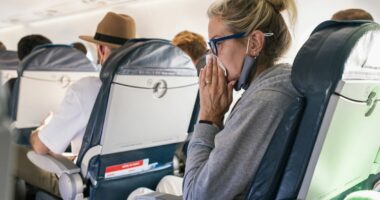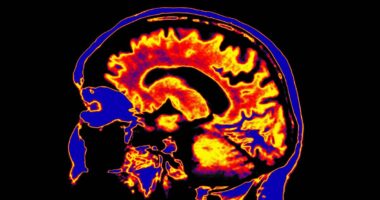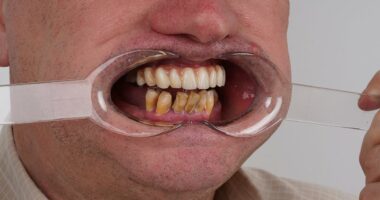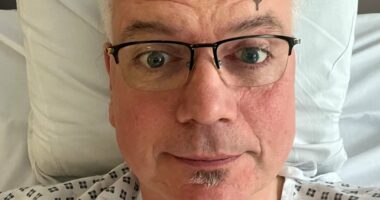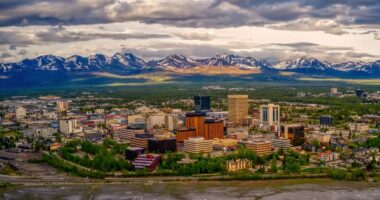Share this @internewscast.com
Sierra Domb was driving to college when suddenly her vision completely blacked out.
She managed to swerve off the road and park despite physically shaking with fear.
A few minutes later her eyesight gradually returned — but it has never been the same.
That moment, back in 2015, marked the beginning of her battle with an extremely rare neurological condition known as visual snow syndrome.
The condition is often described by people as seeing flickering, tiny dots or ‘snow’ across their entire field of vision.
Shockingly, doctors say about 2 to 3 percent of people have it to varying degrees but it’s challenging to get a precise number of officially diagnosed cases.
For most sufferers it’s something they live with but, because of the lack of scientific research, it can be very difficult to get a diagnosis.
A decade on from her initial blackout, Domb, now 30, says it has left her feeling like she’s ‘seeing through a TV with a very bad reception’.
She likens it to a snow globe that’s been shaken up.

Sierra Domb was driving to college when suddenly her vision completely blacked out. That moment, back in 2015, marked the beginning of her battle with an extremely rare neurological condition known as visual snow syndrome
She also has to contend with double vision, extreme sensitivity to light, ringing in her ears, and constant headaches.
Her symptoms became so debilitating that she could no longer drive and had to take an extended leave of absence from college.
Because visual snow syndrome is so rare and difficult to diagnose, it took years before Domb finally understood what was happening to her body.
Now, she’s leading the charge to raise awareness for the condition.
‘For years, I struggled to find answers, only to be misdiagnosed and constantly dismissed by medical professionals who claimed my symptoms “didn’t exist” or told me I was “too young” to have serious health problems,’ Domb told the Daily Mail.
‘Soon, even familiar faces and beautiful landscapes transformed into disorienting, nightmarish experiences.’
The Cleveland Clinic notes that visual snow syndrome is a relatively new diagnosis — the term was only coined in 2013 — and researchers still don’t fully understand what causes it.
Some scientists believe it may be the result of overactivity in the parts of the brain responsible for processing images.
In some cases, experts have found the syndrome in people who also suffer from anxiety or migraines — conditions often preceded by ‘auras,’ or sensory disturbances that can include ringing in the ears, flashing lights, or even speech and language problems.
Auras associated with anxiety are often linked to heightened sensitivity and hyperstimulation, which can trigger visual or sensory distortions.
While Domb was desperately hunting for a diagnosis, she was prescribed medications that actually made her symptoms worse.
‘The doctors who took me seriously warned that I was likely going blind, but they couldn’t confirm when or if it would happen, as my medical tests on my eyes consistently came back “normal”,’ she recalled.
‘This is because visual snow syndrome is a neurological condition so standard eye tests will not work.’
There is no cure for visual snow syndrome but, along with medication, treatment options include therapy to help reduce stress and specialized lenses.
‘The popular notion that my twenties would be the best years of my life quickly turned into a nightmarish medical odyssey I wouldn’t wish on anyone,’ Domb said.

Because visual snow syndrome is so rare and difficult to diagnose, it took years before Domb finally understood what was happening to her body

After realizing she was suffering from visual snow syndrome, Domb founded the Visual Snow Initiative to raise awareness and support others who were ‘suffering in silence.’ She now travels the world talking about the condition and helping others
‘It was devastating to feel invisible and alone in my struggle.’
Despite everything, Domb threw herself into research and eventually discovered that others were suffering from the same mysterious symptoms.
She said realizing she wasn’t alone was ‘both comforting and heartbreaking.’
‘Many shared their pain and frustration, and some, feeling desperate and without the resources or support they needed, even suggested suicide as a way out,’ she added.
After realizing she was suffering from visual snow syndrome, Domb founded the Visual Snow Initiative to raise awareness and support others who were ‘suffering in silence.’
Since she launched the organization in 2018 — three years after her symptoms first appeared — it has heard from patients in 93 countries and amassed more than 60,000 followers across social media platforms.
Touching on some of the groundbreaking discoveries she’s helped support, Domb says, ‘Some individuals are born with symptoms, while others, like me, experience onset of the condition at any point in life.
‘Clinical cases show that people as young as 8 years old have developed visual snow syndrome, though onset most commonly occurs during the teenage or young adult years.’
Thanks to her efforts, the condition has now been recognized by the World Health Organization and included in its annual International Classification of Diseases.
In addition to raising awareness, Domb’s organization is helping to fund research into treatment and management options for the little-known condition.
The health advocate and entrepreneur concludes, ‘I wasn’t and am not a doctor – just a patient who had been disregarded, but I refused to let that silence me.
‘My mission was never about proving others wrong, but about giving a voice to those who were overlooked, so no one would have to endure the medical odyssey that I did.
‘Recognition from the WHO is historic and lives forever. I am deeply grateful.
‘But this is just the beginning. With continued support, I hope Visual Snow Initiative can continue pushing for further advancements in research, treatments, and patient care.’



